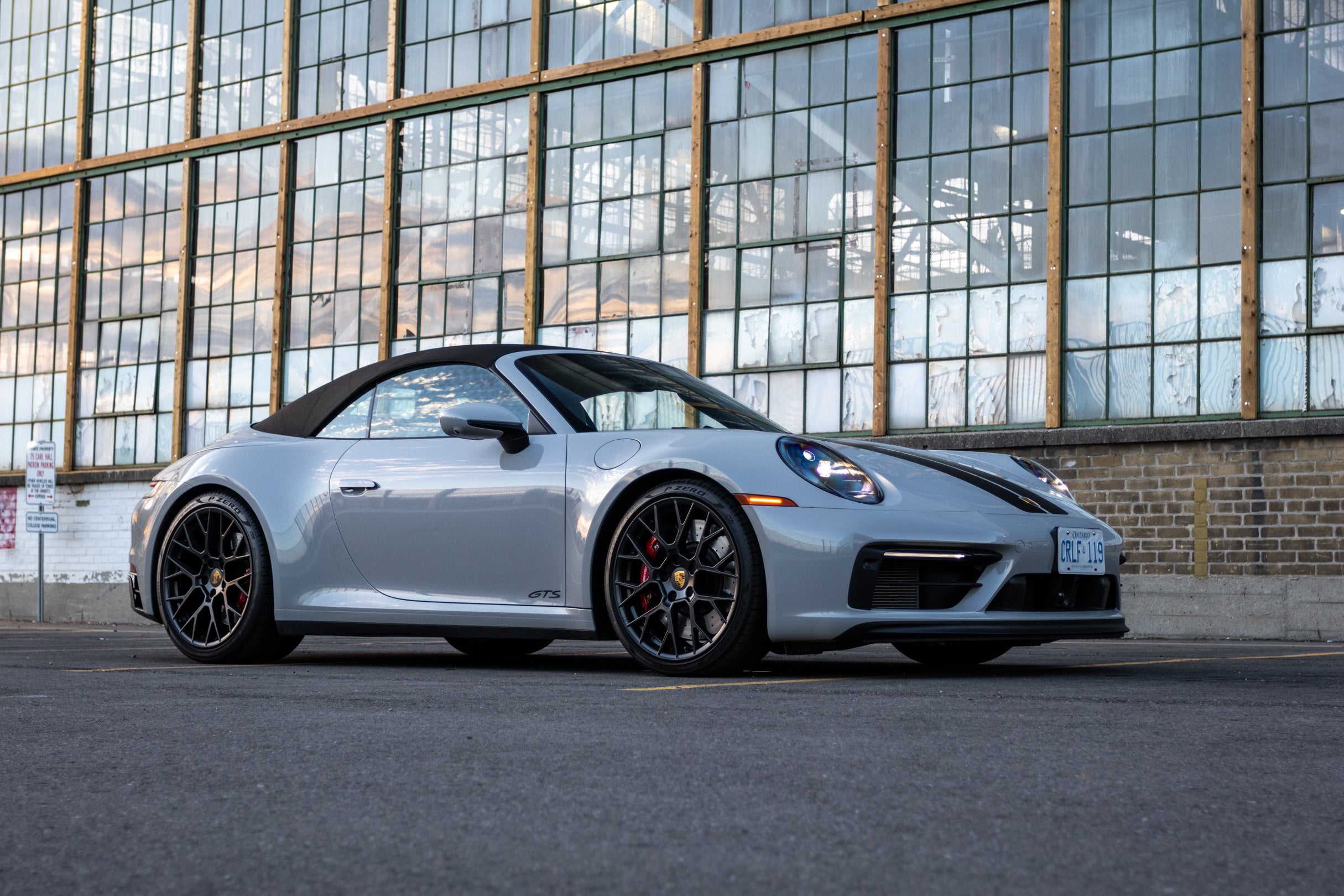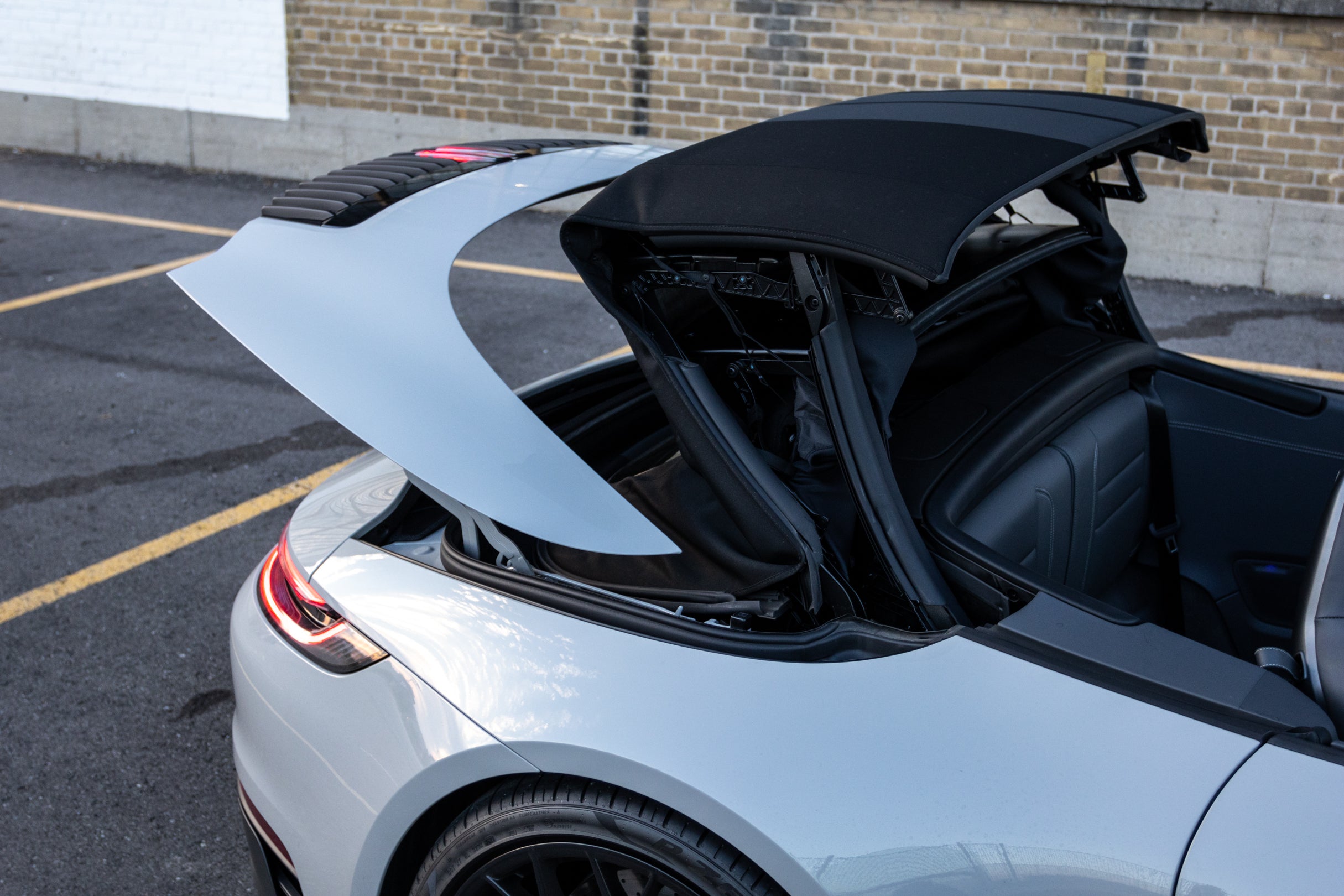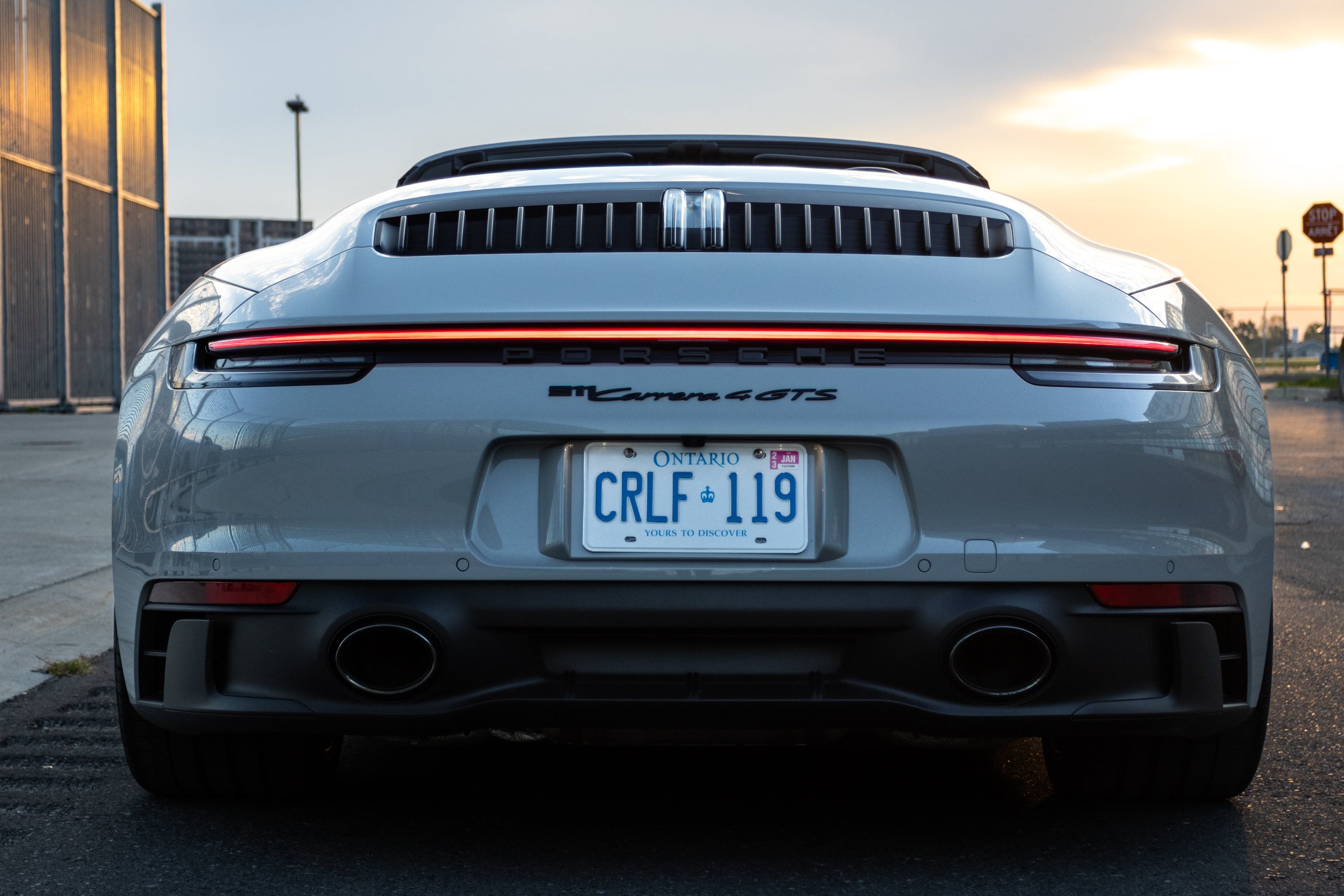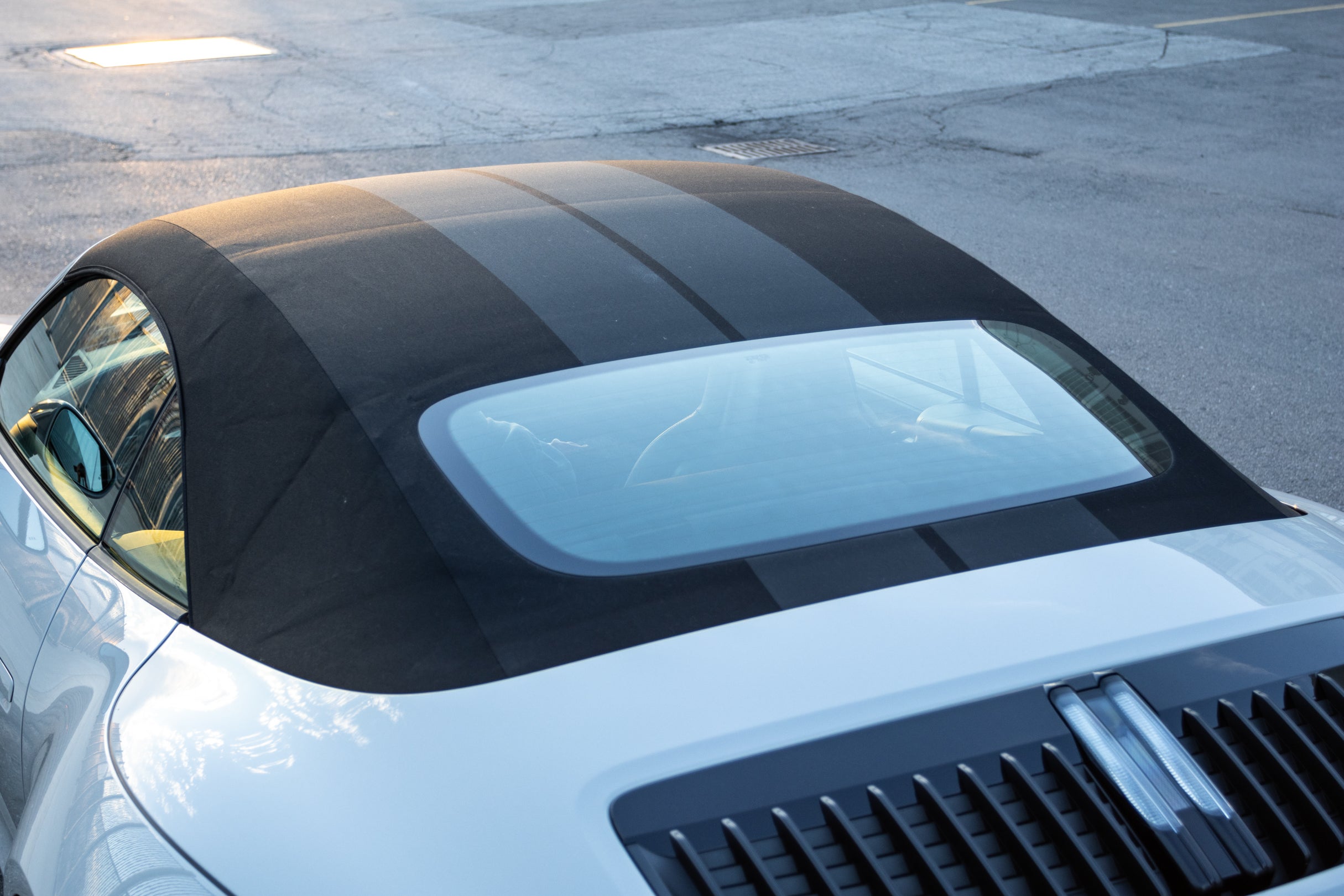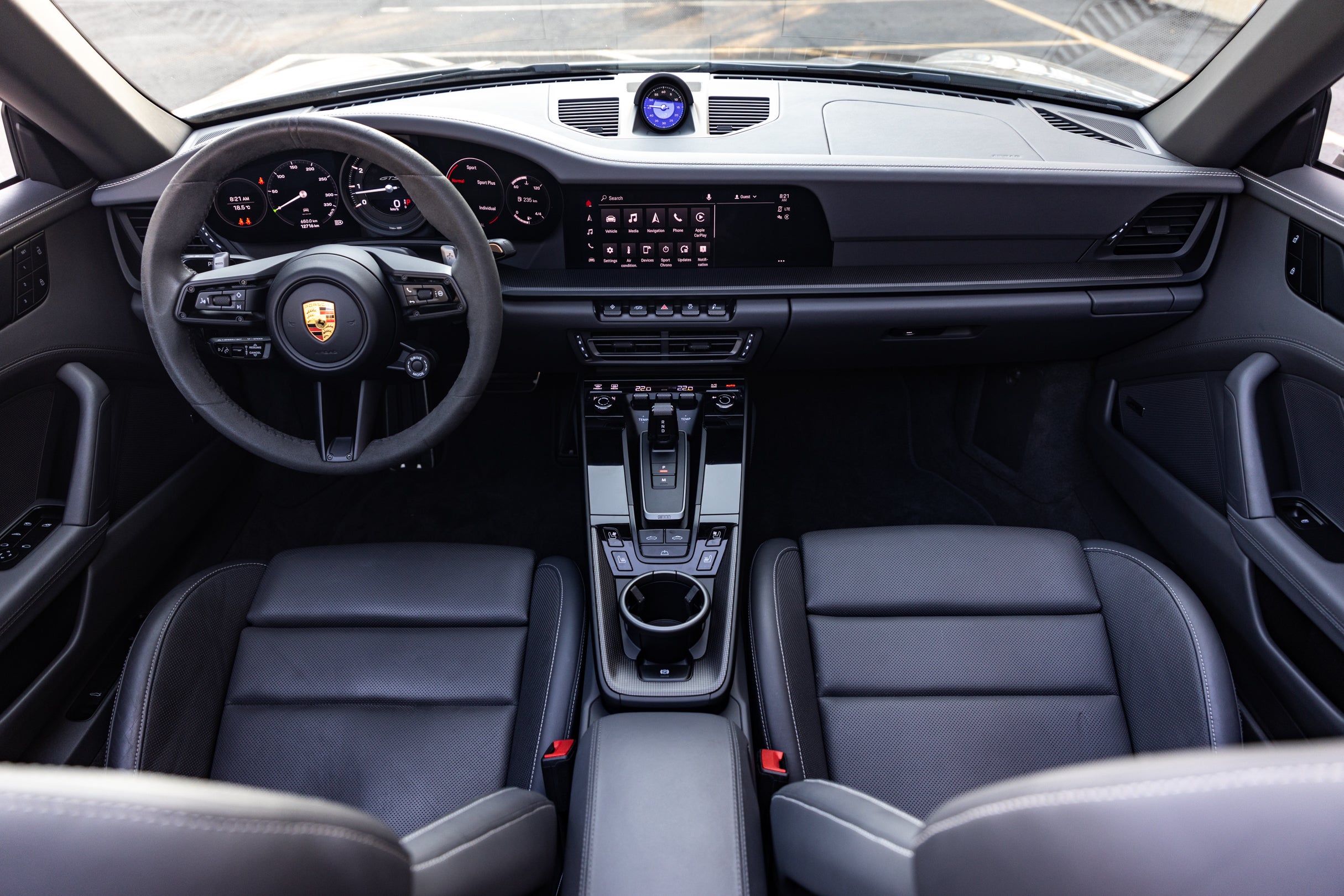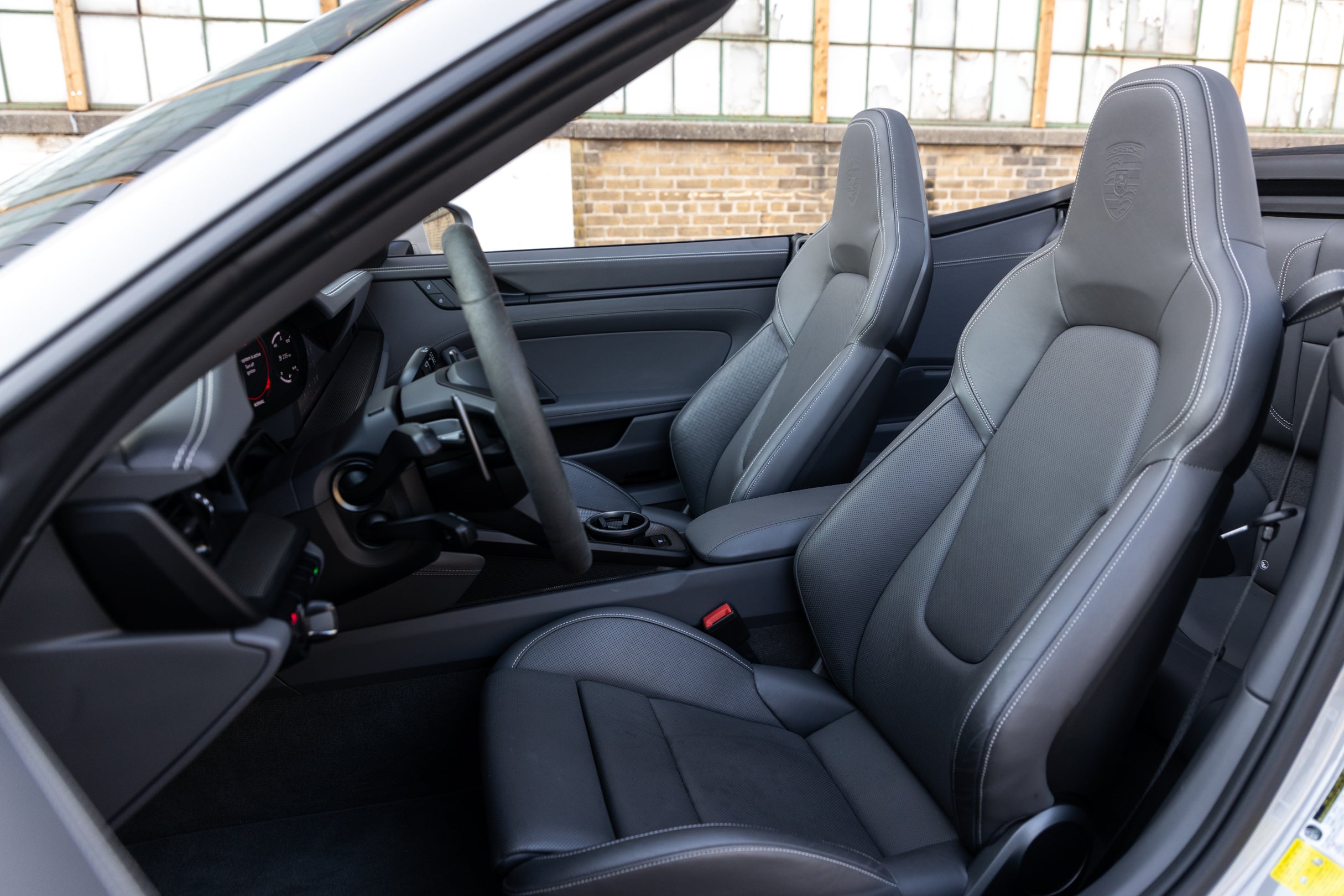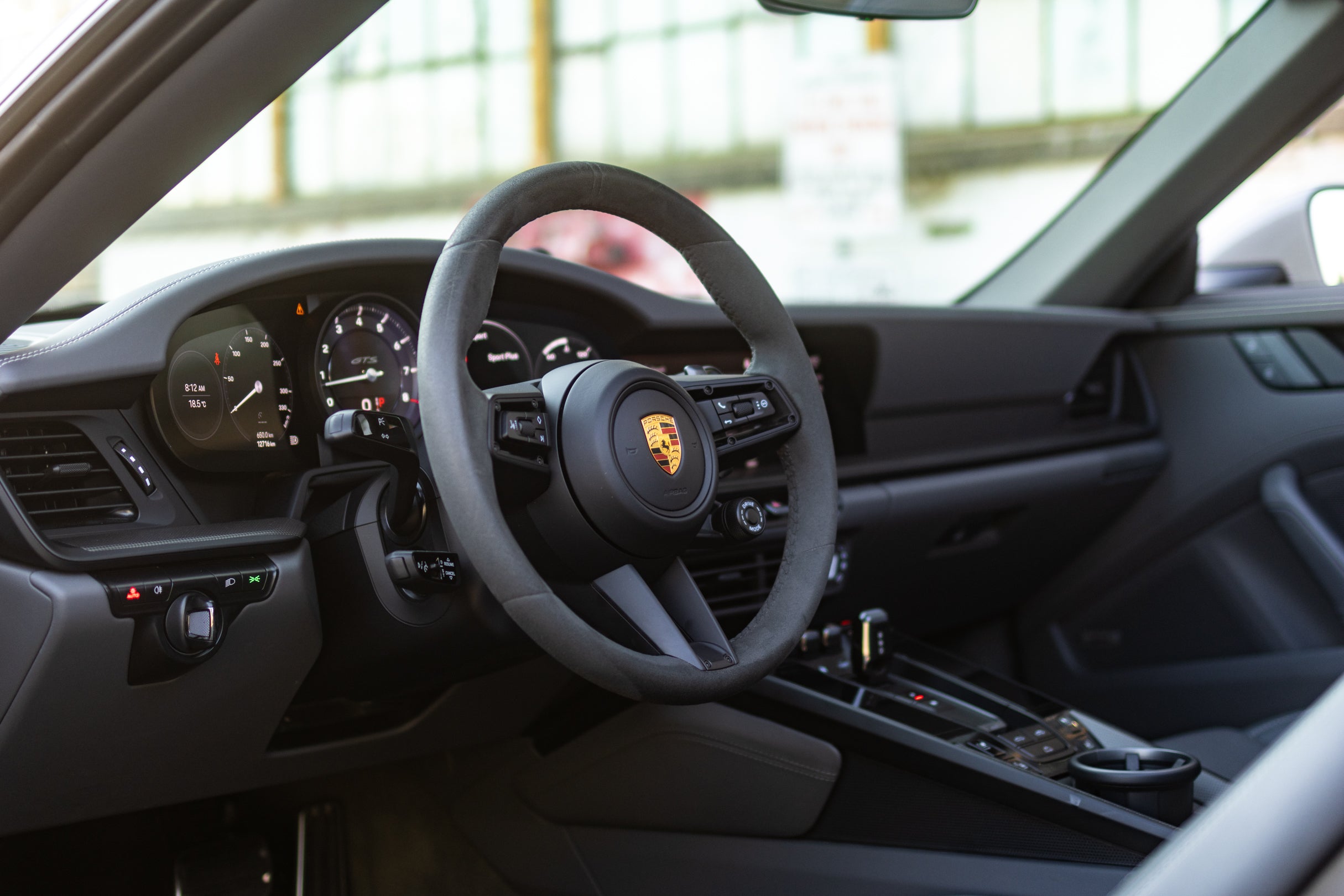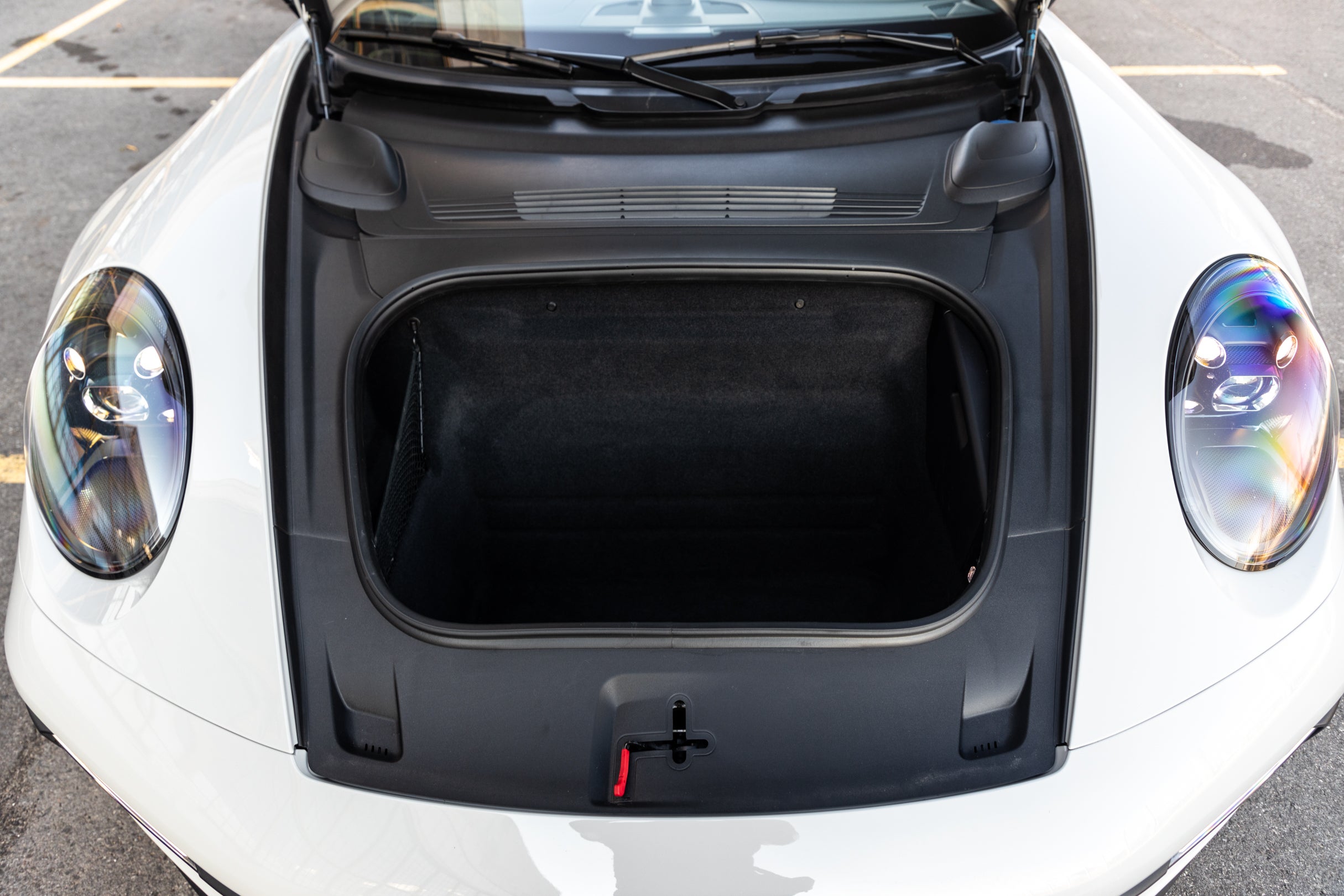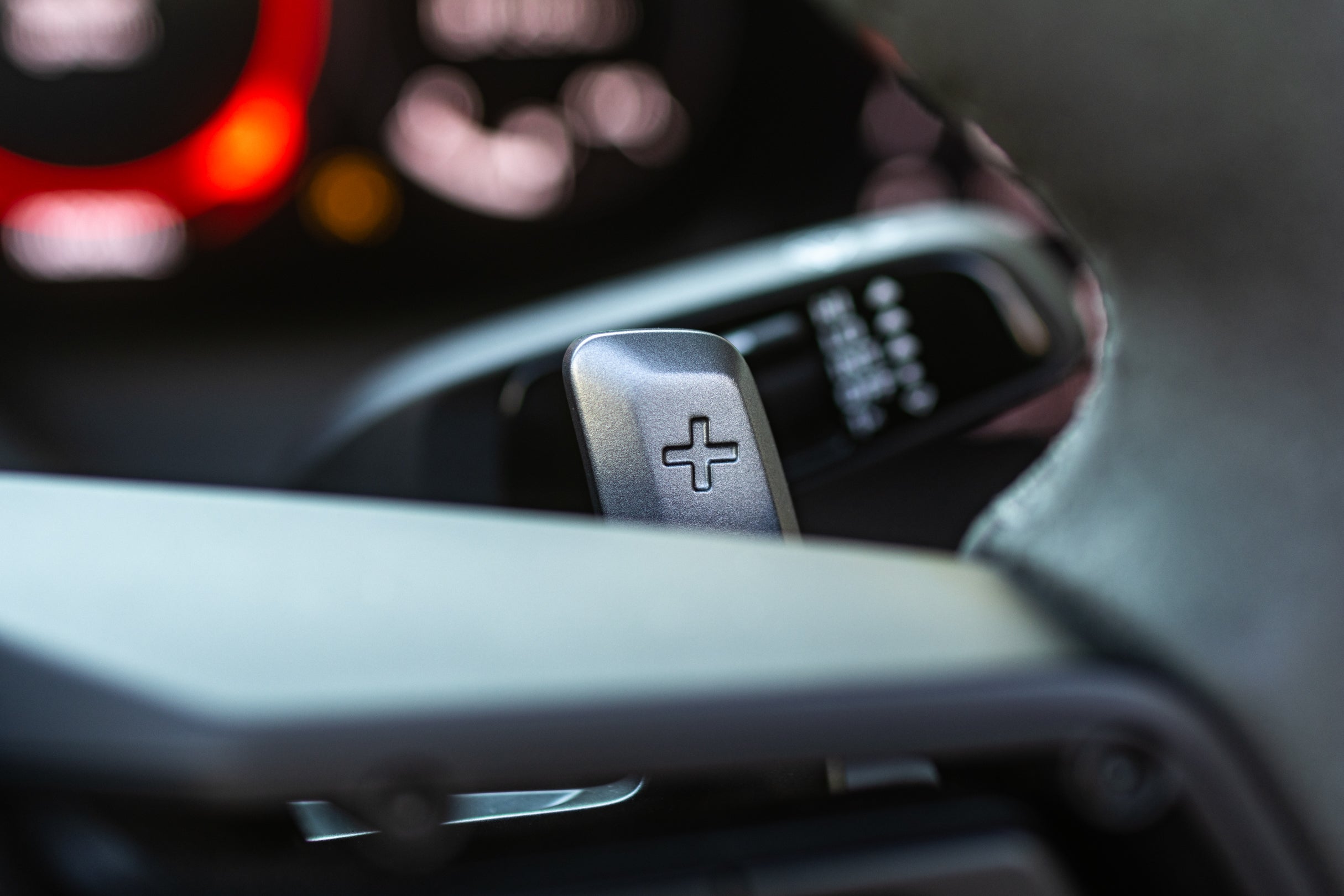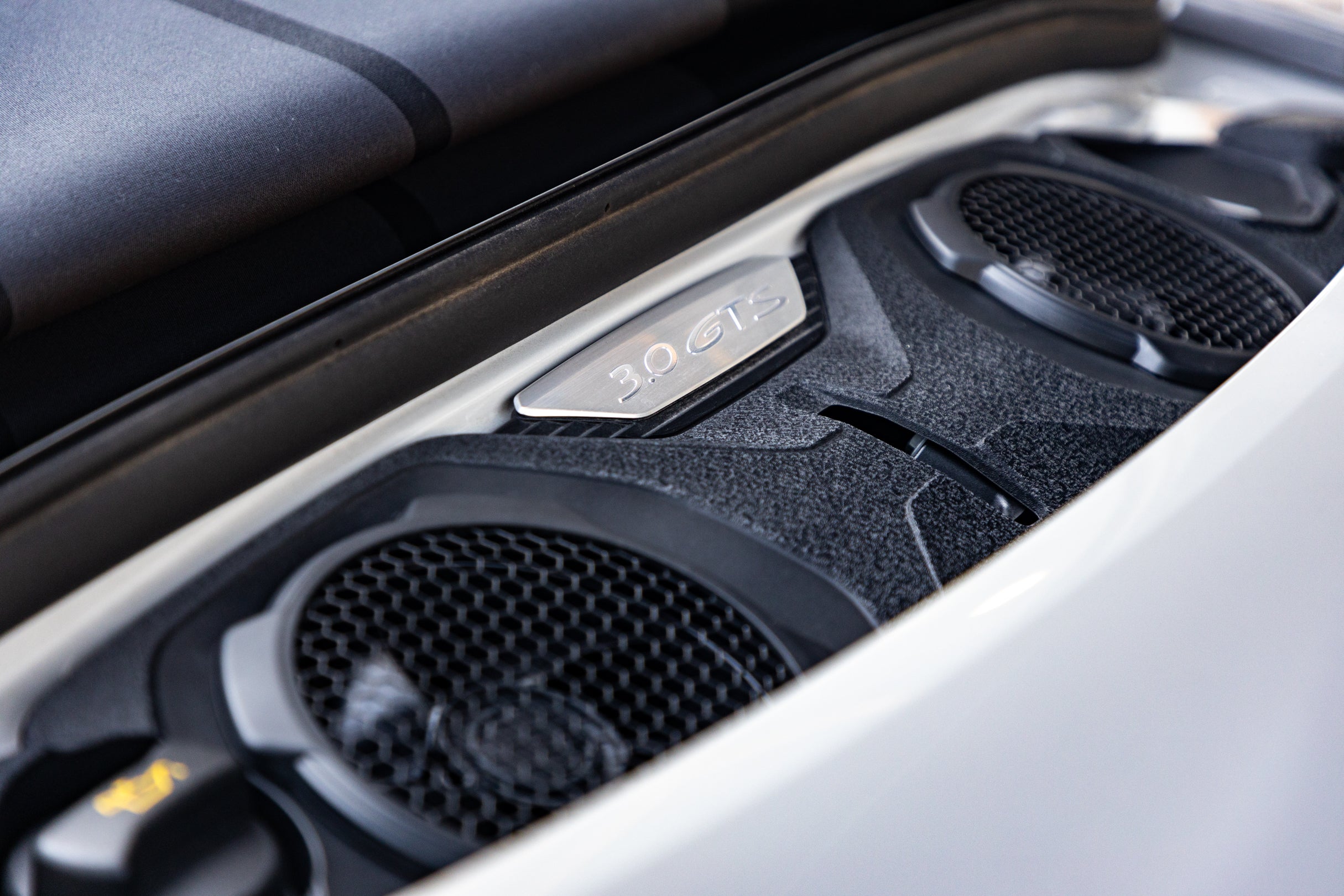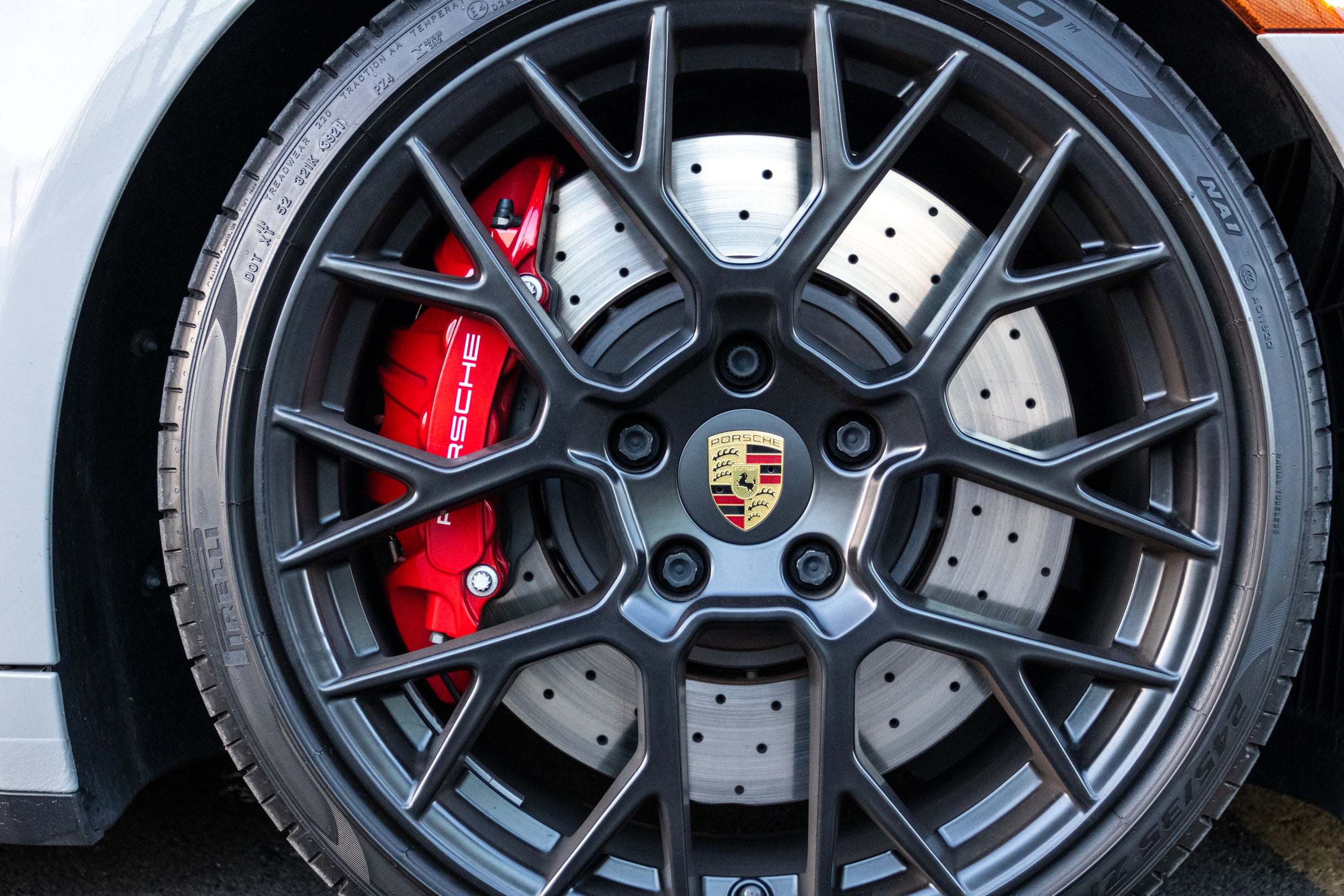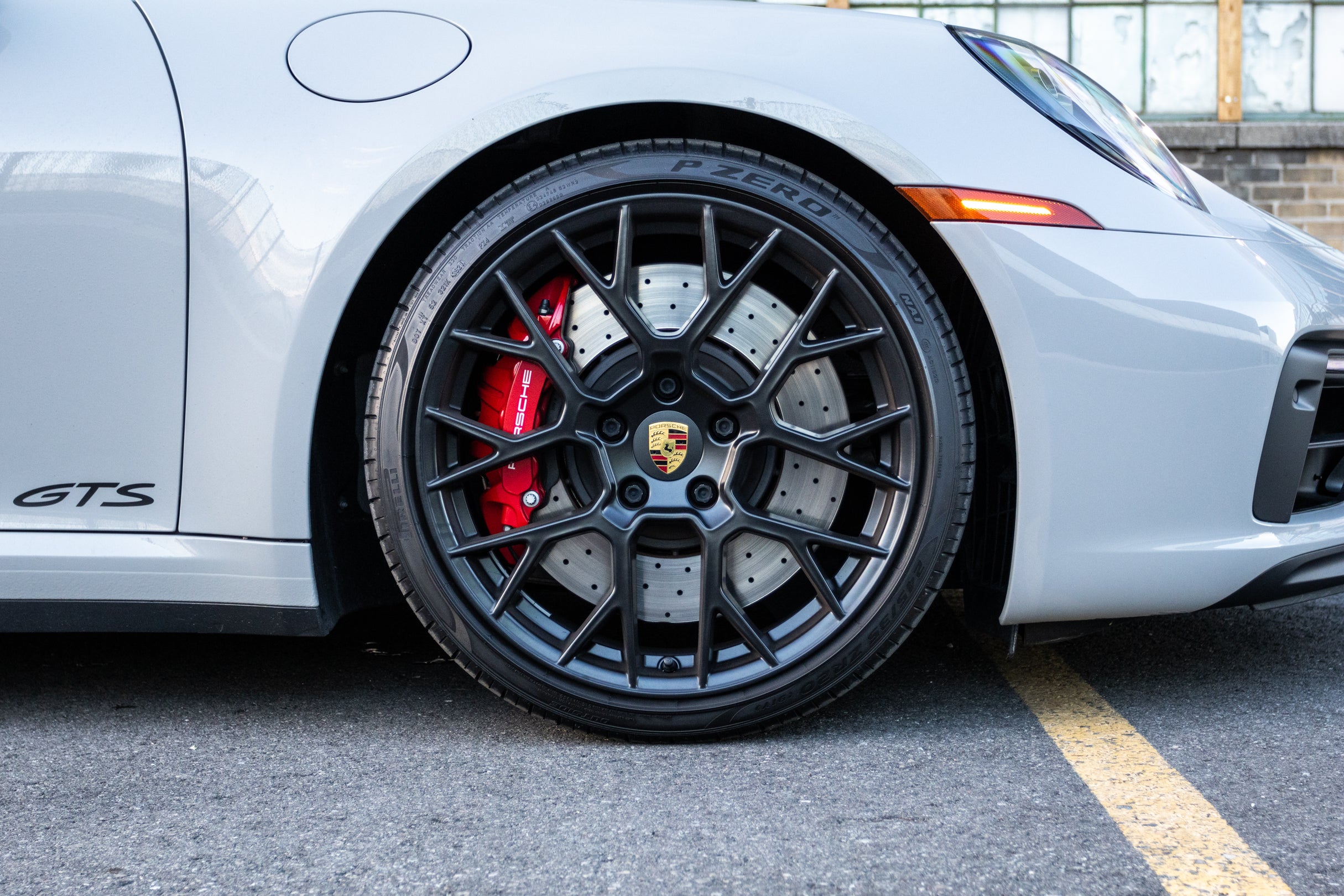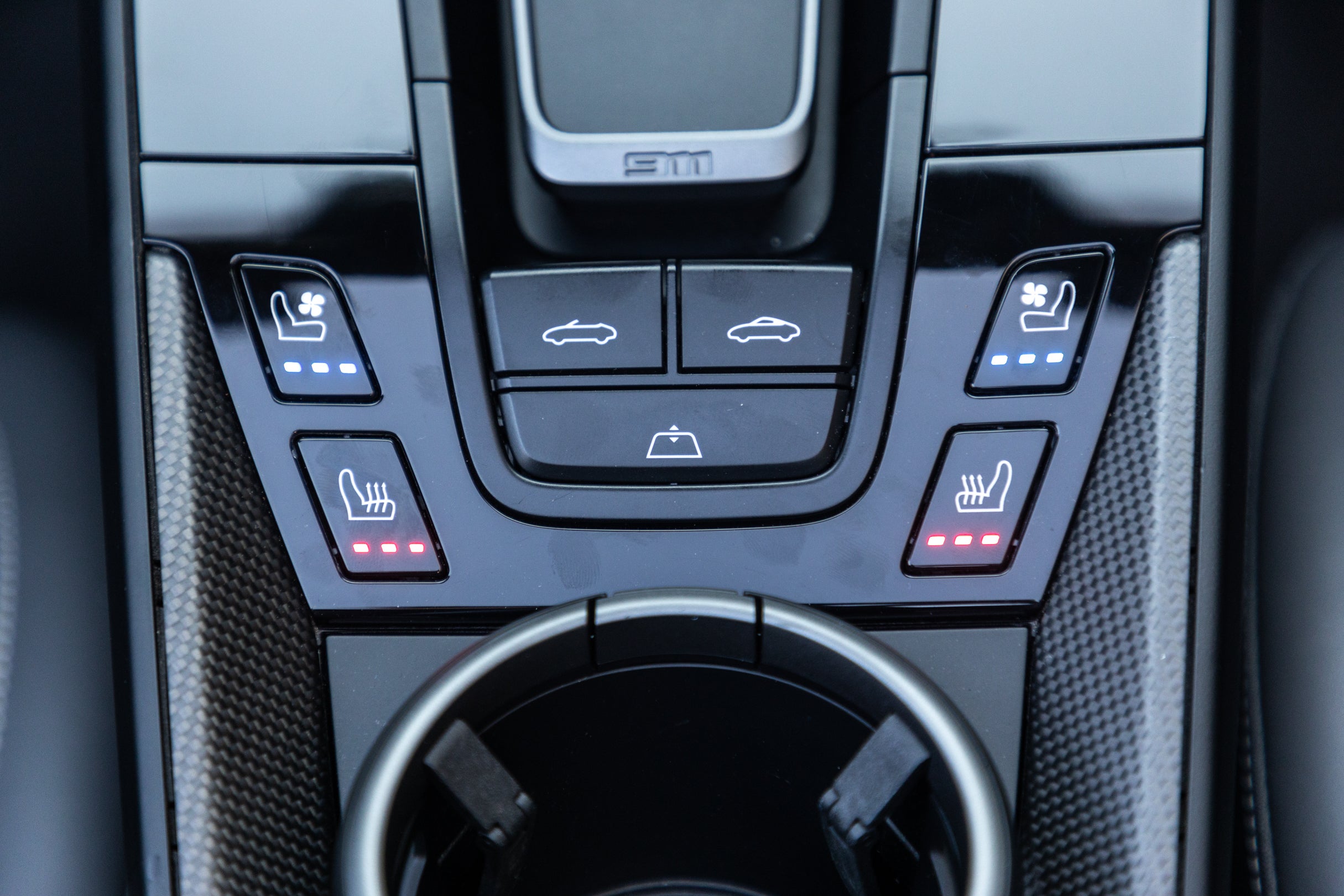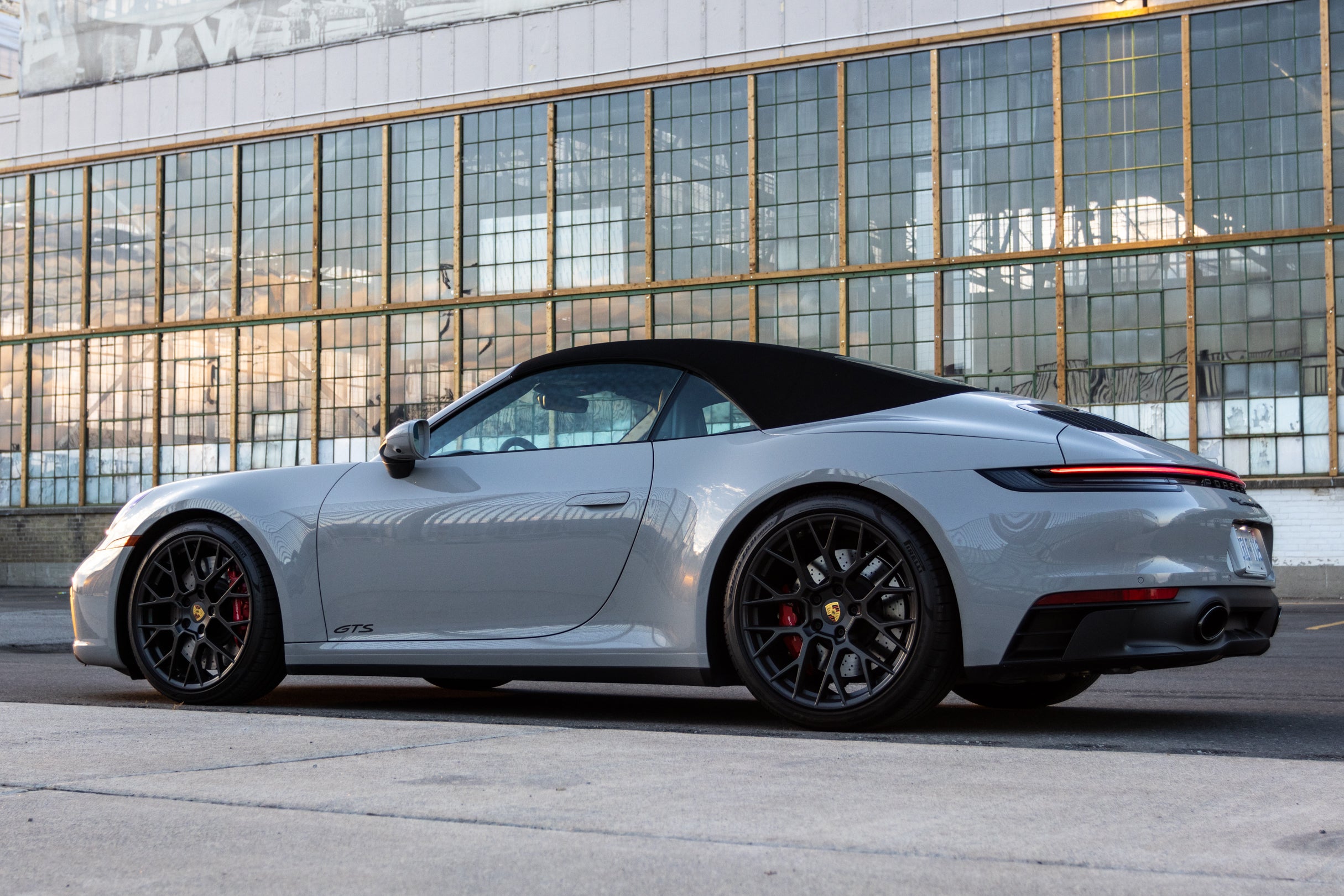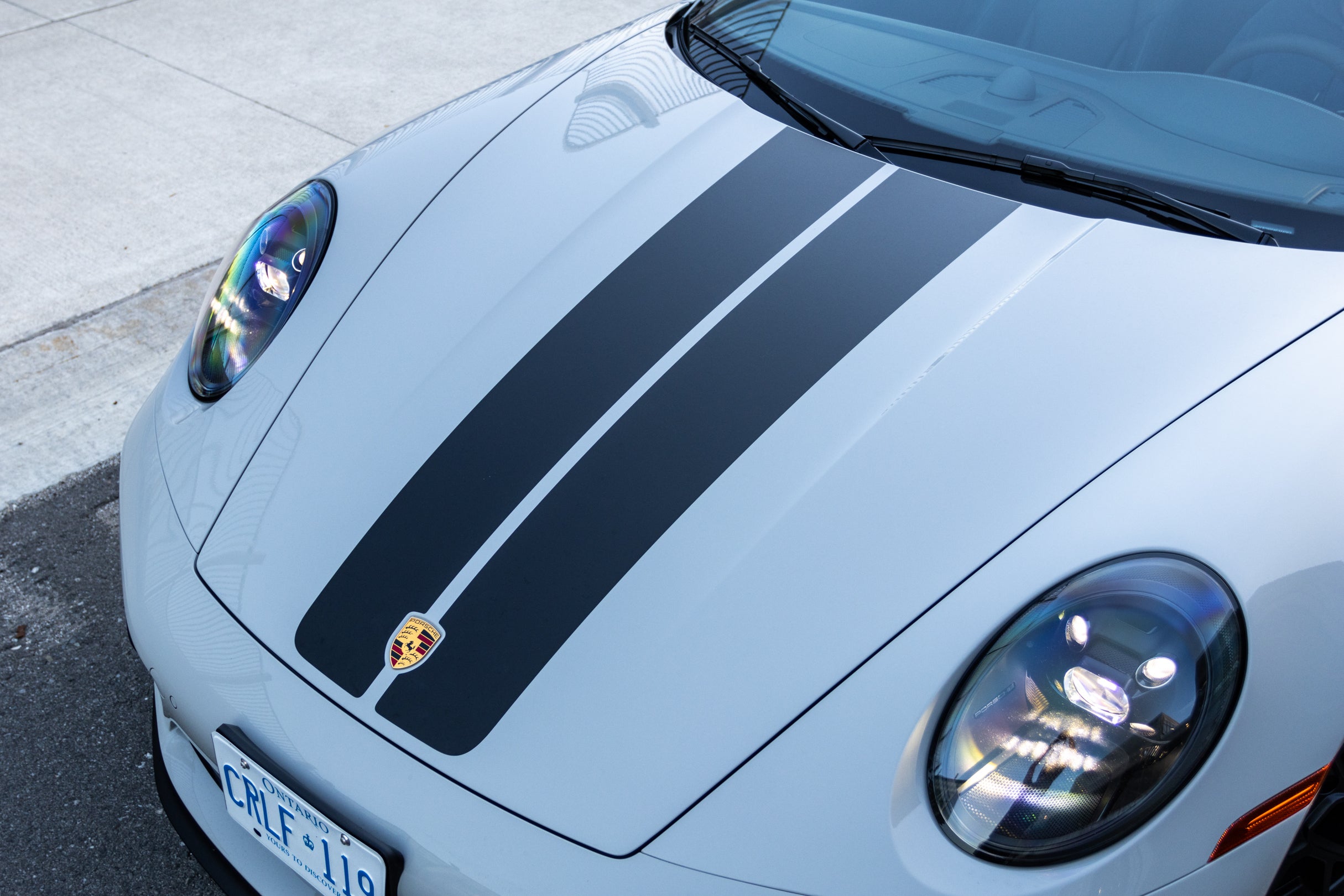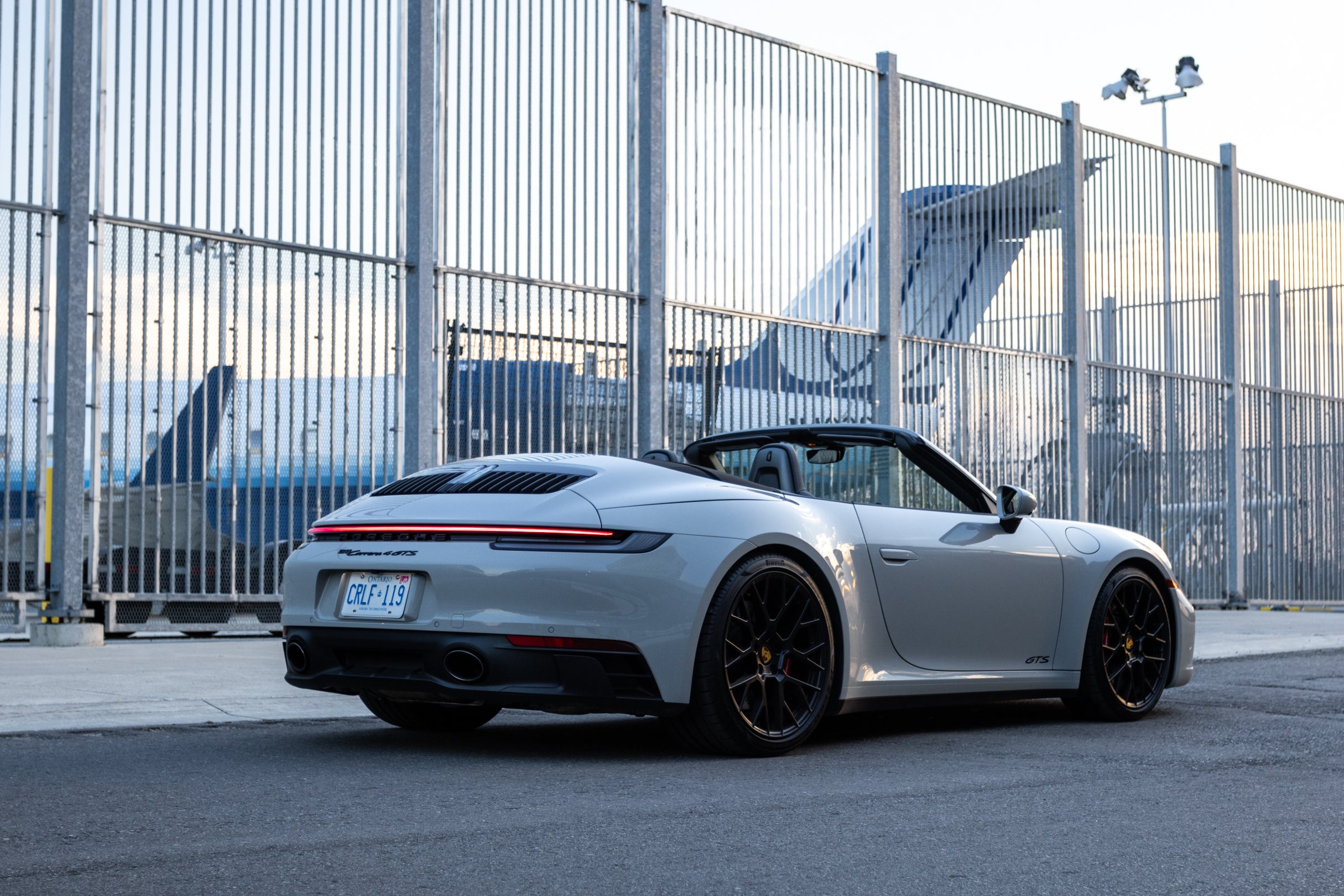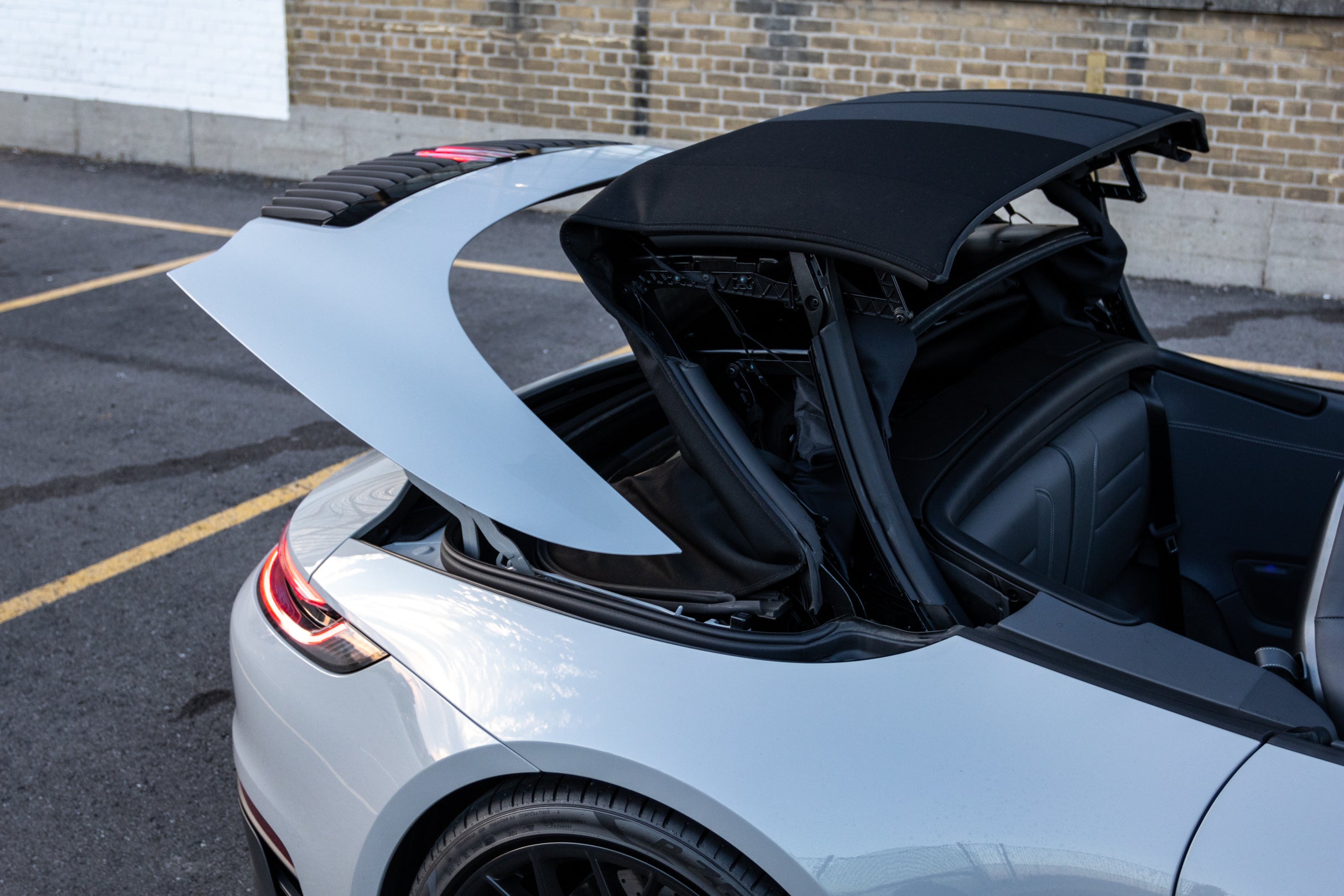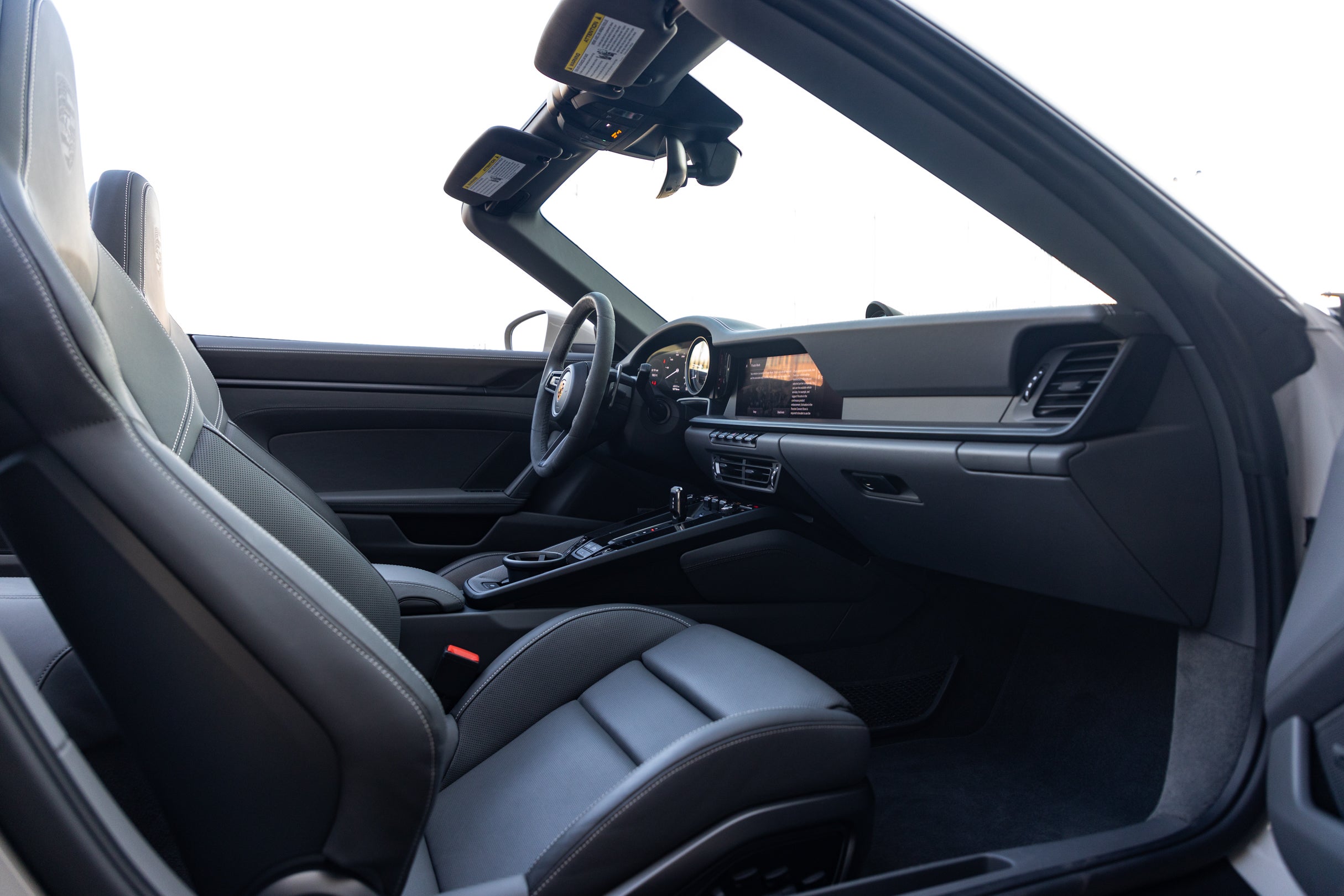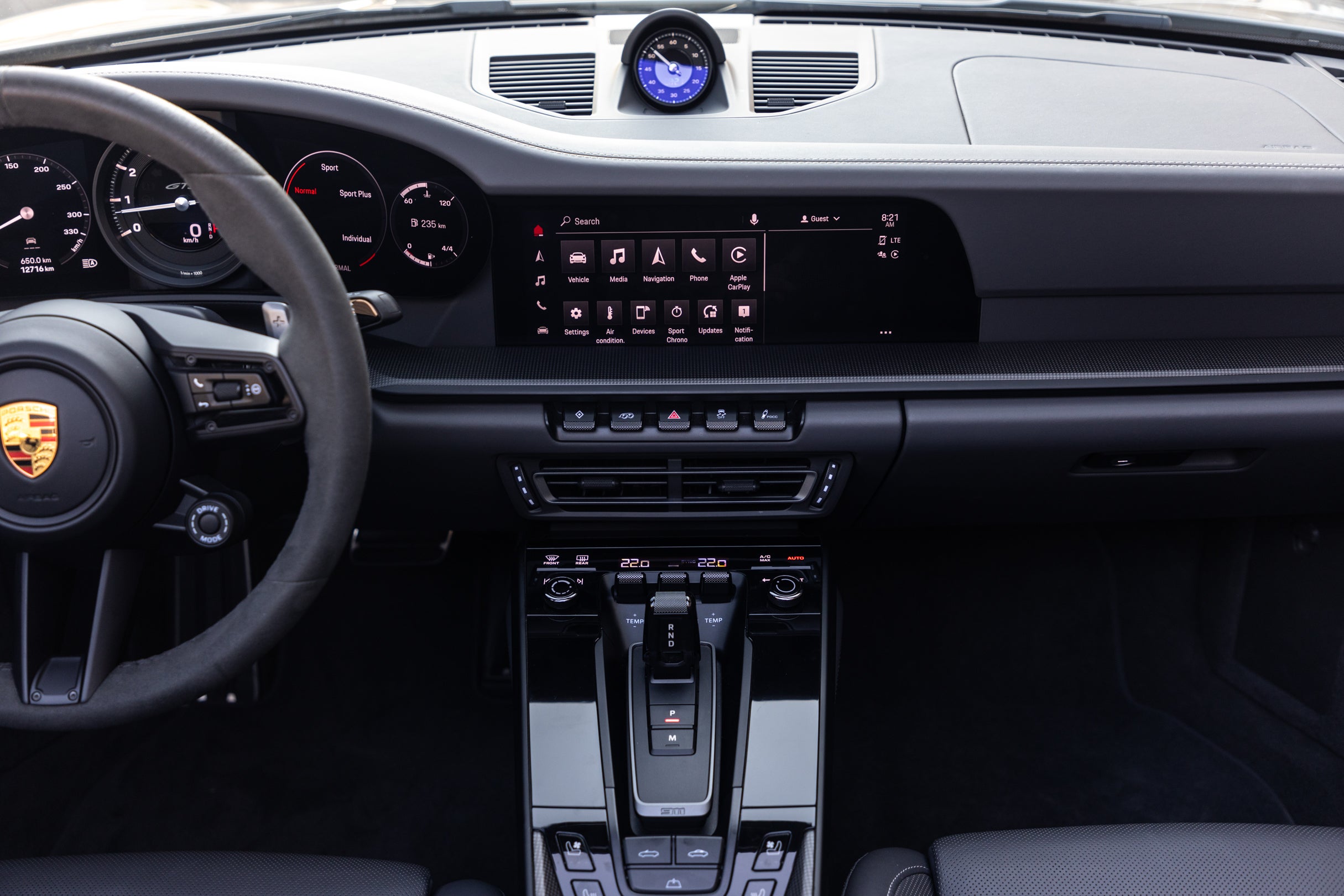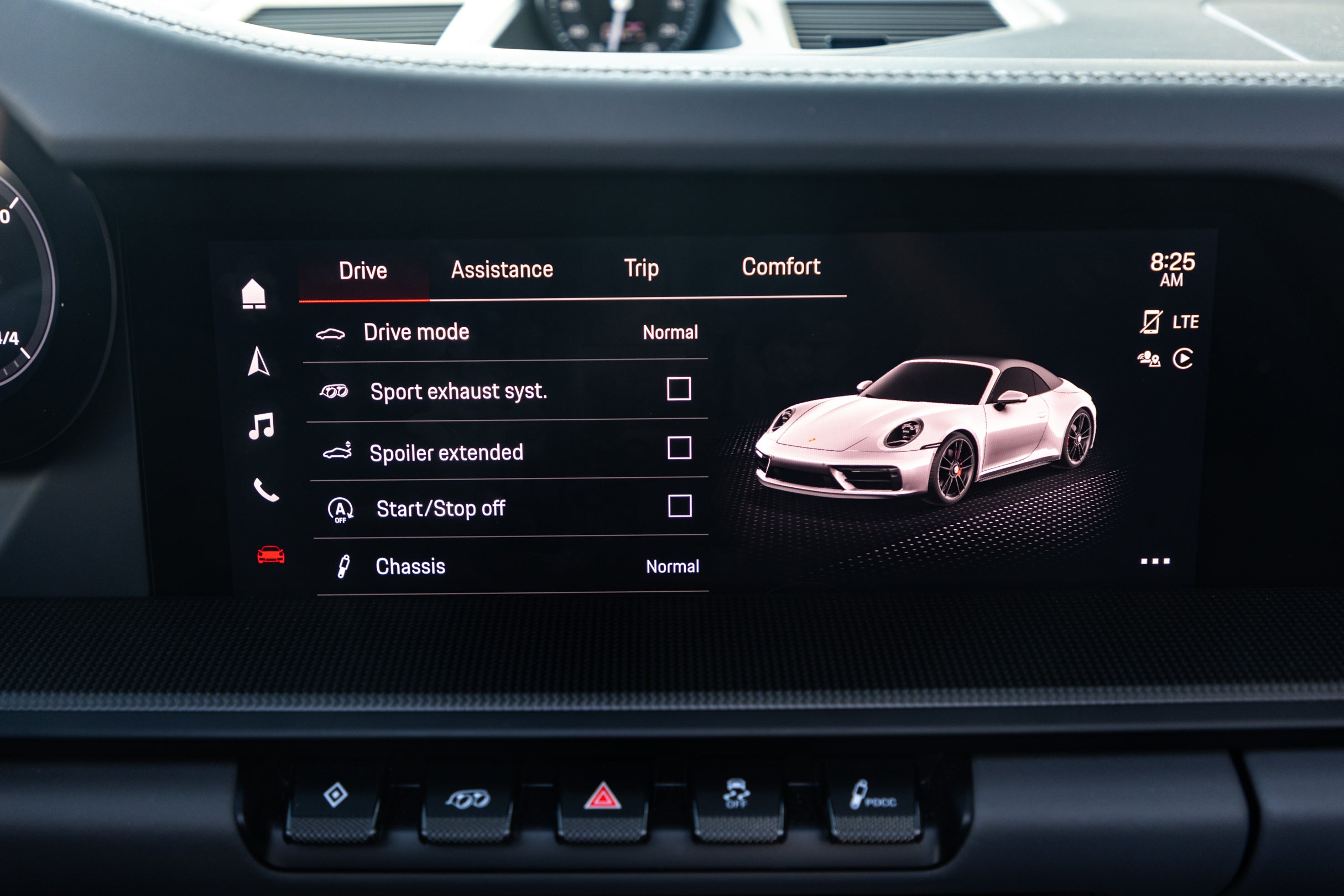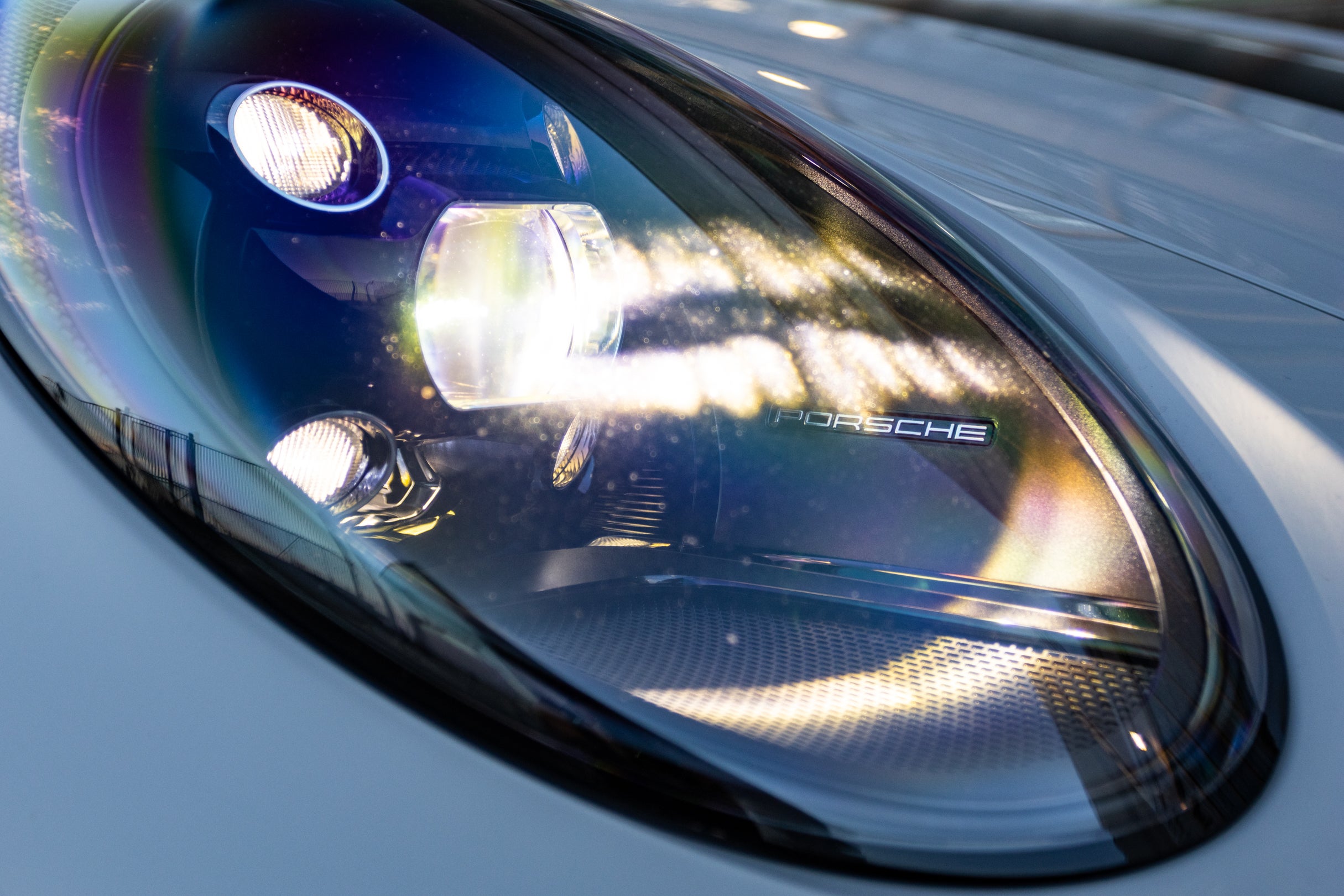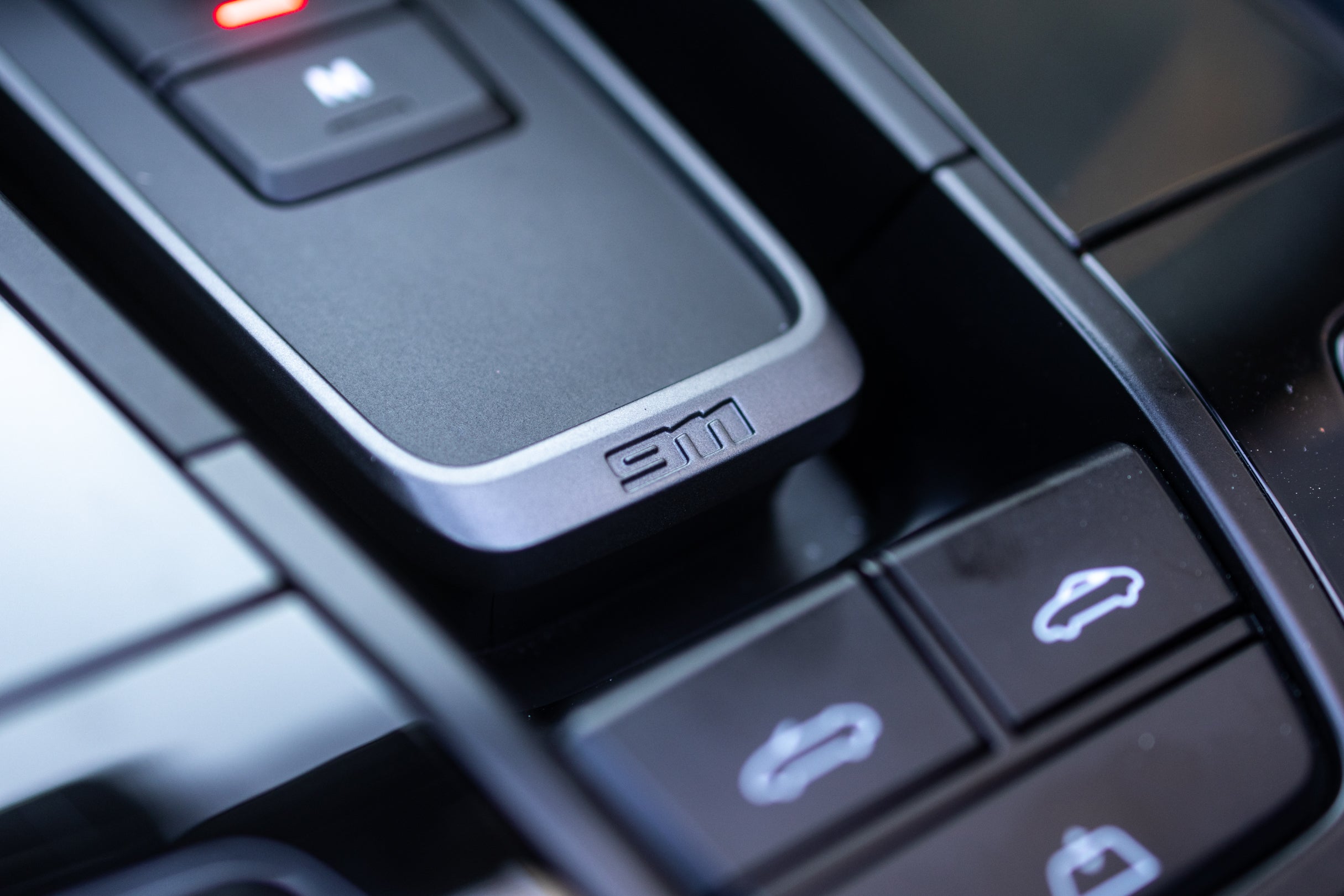Every time I climbed into the 2022 Porsche 911 Carrera 4 GTS Cabriolet and tried to start it up, my left leg instinctively went to step on a clutch pedal that wasn’t there. But even without that third pedal, the GTS radiates Real Sports Car energy the second you get in it. Its cabin is low-slung, its seats are perfectly bolstered, and its long, frameless doors subconsciously tell my brain that there perhaps should be a clutch pedal in this car.
Or maybe I happened to own a manual 911 in a previous life and metempsychotic muscle memory was taking over.
In most sports cars, the absence of a manual in favor of an automatic would be a disappointment, but in the case of the 911, Porsche’s PDK system is so good, merely watching and hearing it do its thing is a joy unto itself. The rest of the car, in fact, is of similar quality. The way it goes, the way it steers, the way it rides, the way the automatic wind deflector pops up, it’s all first-rate and simply … better than most other cars out there. But, I mean, you already knew that, right? This is the 911 we are talking about.
Michael Tsui
Within the vast Porsche 911 range, the GTS is commonly regarded as the Goldilocks 911. Believe it or not, the G in GTS actually stands for Goldilocks. [Ed. note: No, it doesn’t.] More potent than the S but not as almighty or expensive as the Turbo or GT3, its twin-turbo flat-six has been tuned to make 473 horsepower. Equipped with all-wheel drive, the eight-speed PDK gearbox (a seven-speed manual can be had), and in Cabriolet form, this car gets from zero to 60 mph in 3.3 seconds. For reference, the 443-hp Carrera 4S Cabriolet hits 60 in 3.6 seconds while the 572-hp Turbo Cabriolet does it in 2.8.
Aesthetically, the 911 needs little introduction. In fact, that’s probably one of its most enduring criticisms: shit’s looked the same since the beginning. Porsche nerds, however, will be able to distinguish this GTS model by its black exterior trim and darkened lights all around. I’m not really a fan of this tester’s black racing stripes which have been stuck onto the soft top in addition to the hood. I dunno about you but stripes on a soft top feel like a crime against good taste and should be avoided if you’re actually going to buy one of these. More positively, though, all 911s as of this generation get those ultra-wide rear fenders, which—when paired with the soft-top—give them an almost 356 Speedster-esque look in the metal.
Michael Tsui
Similarly, the inside is classic 911. Luxuriously utilitarian, its layout is a clear nod to the original cars’ cabins. I especially like the mechanically ornate analog tachometer that really does bring to mind an expensive-ass watch—something that’s surely intentional given the owner stereotypes surrounding this particular vehicle.
Driven around town, the 911 feels extremely docile while maintaining a sense of occasion through its steering. Your hands feel more directly connected to the rack than they do in regular cars, even when pulling out of parking lots. The ride is reasonably comfy, too, and it’s a great GT car on the highway, even with the top down. The windows and that auto-up wind deflector make the cabin fairly serene and wind-free even at high speeds.
Michael Tsui
If you can cope with the obvious space limitations of a sports car like this (this car’s frunk will not fit a new 24-inch iMac, nor was I very comfortable sitting in those rear seats), the Porsche 911 is very livable and a more-than-viable daily driver in pleasant climates. But plenty of cars do that. Where the 911 shines is as a weekend corner carver. Turning the steering wheel-mounted drive mode dial into Sport or Sport Plus is always accompanied by a cheeky growl of a downshift as if the car is saying, “It’s showtime.” And, you know what? It really is showtime.
I’m honestly not sure if the whole rear-engine thing even has much to do with this anymore (and I frankly don’t really care) but the 911 doesn’t really steer like anything else I’ve driven. It’s more eager, lighter-nosed, quicker to turn in. The chassis is a formidable match for it, too, feeling extremely cohesive and soundly put together. Stable, sharp, and uncannily confident through bends, the Porsche 911 is an instrument of lateral movement.
The powertrain isn’t bad either. Plant one foot on the brake in Sport Plus, mat the accelerator simultaneously, and then let go of the brake and you’ll be treated to one of the most aggressive launch control programs I’ve ever experienced, EVs included. Official stats may say it takes 3.3 seconds to hit 60 mph, but from the driver’s seat, that number feels like sandbagging. Acceleration is properly strong, the kind you can feel in your cheeks and eyeballs and it’s all scored with a sonorously shrill flat-six wail.
Sounding grungy and mechanical at low-to-medium revs (as boxers are wont to do), the 911 GTS absolutely screams at high ones. Turn the stereo off and really listen to it; subtle … plumbing noises can even be heard. Wastegates opening and closing. Chains and belts whirring. Turbos spooling. It all happens relatively quietly, but it is there. Of course, the real magic happens at the last few hundred rpms. Run this car up past 7,000 and it’s as if a whole other instrument joins the orchestra while everybody moves up an octave, sounding a bit like the world’s angriest teenager refusing to stop up-talking at the end of every sentence like it’s a question even when it, like, isn’t? Instead of mild annoyance, though, the Porsche’s redline lilt is a crescendo into aural 911 heaven.
Michael Tsui
PDK is as good as its reputation says it is. Manual shifts come immediately every time, but leaving it in auto means it usually does what you were going to tell it to do anyway.
Approach a corner and you’ll find a brake pedal that’s reasonably lengthed up until the bottom of the travel, at which point it becomes more of a very precise, pressure-sensitive button. Step on the pedal, hit a soft wall, and brake pressure is related to how hard you press down, not how far your foot travels. It works well and is a very serious and accurate performance car idiosyncrasy I only ever remember getting from the old E28 BMW M5 and, to a lesser extent, the Cadillac CT5-V Blackwing.
Everything about this car responds, moves, and reacts quicker than it does in most other cars, whether that’s steering-, throttle-, or transmission-related. Excitingly impressive, it was even more fun than I expected and feels about as raw and mechanical as I’d like a potential daily driver to be. However, because this is not The Ultimate 911, you do indeed get the sense that the steering could be even quicker, the nose even lighter, the grip and noise even more compelling. I caught myself thinking, “If only this were rear-wheel drive, if only this were manual, if only this were even lighter …” If only this were the GT3. Porsche’s always been good at that though: giving you exactly what you pay for within its hierarchy. Nothing more and nothing less.
If it were me, I’d also lose the Cabriolet part of its name because I actually enjoyed this car more with the top up than I did down. The enclosedness fits its dartily capable sports car personality better, and I didn’t find any aural benefits to being exposed to the elements. Trapping the noise in the cabin with you, echoing against the roof—that’s where I think this engine sounds the most on the money.
Michael Tsui
Like every single Porsche I’ve driven so far, build quality is sublime. Everything operates, clicks, thunks, and ticks in a satisfying manner. Other than that, the 911’s reputation as a jack-of-all-trades, semi-incognito supercar alternative is true. In pretty much every driving situation I put it in, the GTS performed excellently. Being hucked down a twisty road, cruising on the highway, navigating through parking lots. It’s good at it all while being fun, luxurious, and livable. This particular test was done during the heat of summer but I’d be very interested in throwing some winter tires on and seeing how it fares in inclement Canadian weather. This car does feature a wet mode, after all.
Did I say everything clicks in a satisfying manner? Sorry, I lied. You’d expect the wiper and turn signal stalks behind the steering wheel of a Porsche to feel clicky and solid, but these ones unfortunately were not. In fact, they were kind of loose and mushy. Furthermore—and this isn’t exclusive to the 911—but as nice as the screens and switches physically are, Porsche’s UX and software are middling to use at best and involve a big patch of smudge-and-scratch prone gloss black exactly where your hand rests while adjusting the volume. The dead pedal is angled a little too upright. And while Alcantara looks and feels great when new, the left side of this 8,000-mile tester’s steering wheel was already starting to wear down to an unsightly shine.
Michael Tsui
One final Low includes the absence of a seatbelt strap on the shoulder of the seat, which means you have to reach quite far back to retrieve it every time you set off. Lack of seatbelt security also meant the passenger belt kept swinging around when nobody was sitting there, annoyingly tapping and knocking against the hard seatbacks.
Oh, and every once in a while I caught the right wiper, like, twitch randomly. I couldn’t explain why, it was ultimately inconsequential, and it happened infrequently enough that getting video evidence of would have been mighty difficult. But it happened and it was weird, you’ll just have to trust me on this one.
The Porsche 911, as a whole, starts at $107,150, but that only gets you into the base Carrera. In Carrera 4 GTS Cabriolet form, prices start at $164,150. The tester you see here is a Canadian-market car and comes with hella options including special Chalk paint, gray leather with Chalk stitching, rear-wheel steer, Porsche Dynamic Chassis Control, ventilated, 18-way, adaptive Sport Seats Plus, adaptive cruise, the stripes, and the Premium Package which encompasses a surround-view system, folding mirrors, ambient lighting, and lane change assist. According to Porsche Canada’s build sheet, this exact car costs $204,565 CAD. Recreating it in Porsche USA’s online configurator, the same car would apparently cost $189,570 USD in the United States.
Michael Tsui
As far as its competitors go, I’ve had the privilege of driving the Jaguar F-Type R, Lexus LC 500, and BMW M8 Competition. The Lexus and the BMW are arguably just as good as the Porsche when it comes to long-distance grand touring and everyday tractability but, likely on account of the 911 having its engine in the back, the Porsche outdoes them all when it comes to backroad handling. On the other hand, one could easily argue that the Jaguar and the LC are more visually appealing.
Per the EPA, this specific 911 is rated for 17 mpg in the city, 22 on the highway, and 19 combined. After 300 miles of mixed driving, I observed about 18 mpg. Auto start-stop is standard equipment and works as it’s supposed to. Naturally, premium fuel is required.
It hasn’t happened yet, but the 911 is expected to go hybrid sometime within this generation.
Par for the Porsche course, the 911 isn’t an inexpensive proposition, especially if you’d like one with a lot of the modern luxury amenities that would typically come with a six-figure car. As-specced, it’s borderline supercar money. But, to be fair, it’s serving up borderline supercar thrills, too.
Impeccably composed, granite-like in quality, and magnificently exciting to wind out, it really does deserve its legendary status. I’m not sure Carrera 4 Cabriolet would be my 911 GTS configuration of choice—actually, I know it wouldn’t be—but even with the added heft of all-wheel drive, that retractable top, and the silly stripes, you can definitely tell there’s a showstopping race machine lurking not too far under the GTS’s surface.
Michael Tsui


